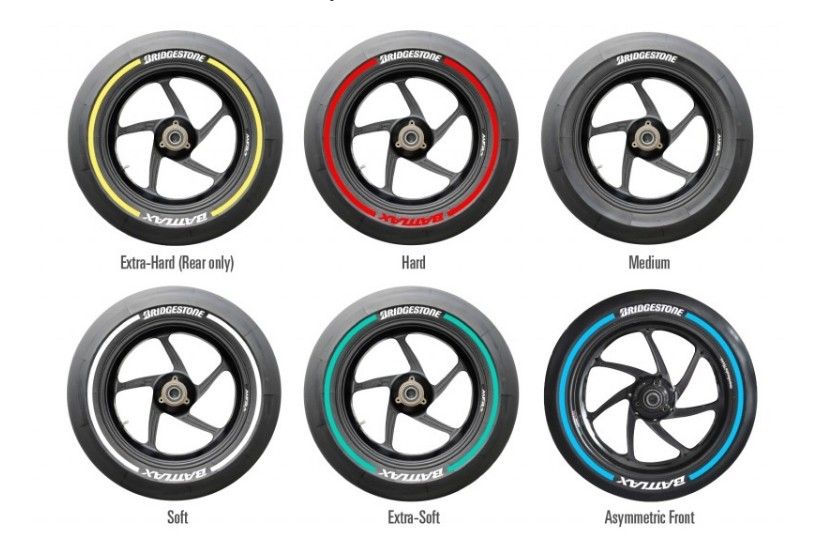The 2015 MotoGP->ke2192 season is about to begin and while Bridgestone’s contract as the official tire supplier of the racing series->ke2345 is up after this season, you have to give credit to Bridgestone for continuing to put the best products out there for the series teams and riders. Part of Bridgestone’s responsibilities for MotoGP is to devise a tire marking color code to make it easier for teams to identify which specific set is suited for a specific time or racing condition.
This season, Bridgestone has unveiled six different tire color codes for MotoGP, two more than what it had in previous seasons. Some of us already know the four color indicators - standard or medium tires are unmarked; the one with the red stripe is the hard tire; the one with the green stripe is the extra-soft tire used exclusively on the rear; the one with the white stripes is the soft tire - that were implemented last season. But now, Bridgestone is adding a yellow-striped tire for the extra-hard compound and a blue-striped tire for the asymmetrical tire that will be exclusively used on the front end.
Wet tires will also follow the same color-coding scheme as last season with white strips earmarked for soft wet tires and black strips used for hard wet tires. These types of thing may not seem like important details for casual fans of MotoGP, but for those who understand the sport and know how important tires are in a rider’s performance, these new color codes will go a long way in helping who the 2015 MotoGP world champion is going to be.
Personally, I'm just excited to see the series return to action. Formula One->ke190 has already started so it's time for MotoGP to get in on the fun too.
Click "continue reading" to read more about Bridgestone's new color coded tires for the 2015 MotoGP season.
Why it matters
MotoGP’s color-coding system was actually introduced last season as a response to demands from race-viewers who wanted to clearly identify what type of tires each rider was using at specific parts of a race. But the purpose evolved to helping teams, as well, so you can say that the color-coding scheme has been successful in that front.
But the adoption of new tires goes beyond adding new colors to the tires. There’s also that all-important factor of developing specific tires for specific races, something that the series found out last season and has put great importance in implementing this time around.
Whether that proves to be successful is a discussion for another time, but on the surface, it’s important to have tires that can handle the quirky requirements of race tracks and avoid problematic situations like last year’s race at Philip Island in Australia where stewards imposed a fly-by rule that required to riders to change bikes and ride a new set of tires after every 10 laps.
That may have contributed to the suspense and drama of the race, but it was also a safety issue that needed to addressed quickly. And so, here we are, days away from the opening race of the 2015 MotoGP season.
If you’re a fan of the series like I am, now may be a goof time to get acclimated to these new tire color codes so you know what riders will use during a specific race. That’s the kind of viewer engagement that was made possible with the implementation of this scheme.

